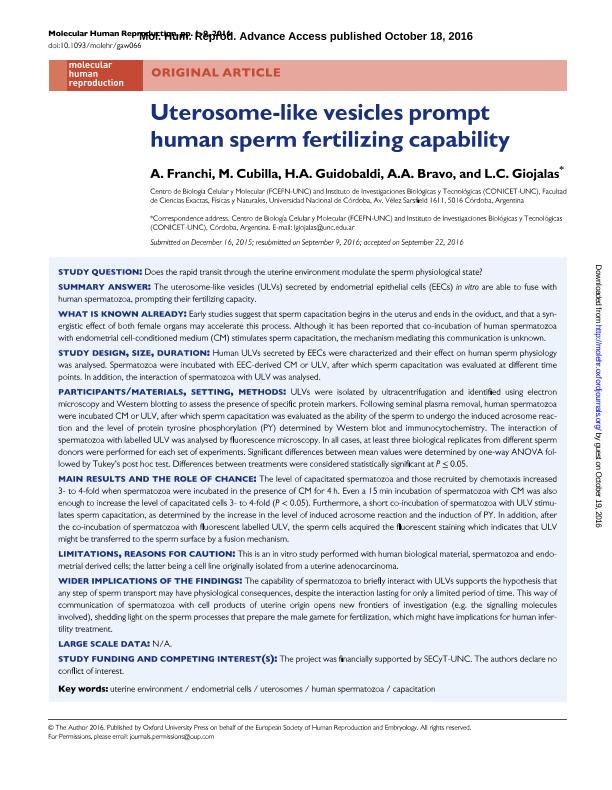Mostrar el registro sencillo del ítem
dc.contributor.author
Franchi, Nilda Anahi

dc.contributor.author
Cubilla, Marisa Angélica

dc.contributor.author
Guidobaldi, Héctor Alejandro

dc.contributor.author
Bravo, Azucena Anahí

dc.contributor.author
Giojalas, Laura Cecilia

dc.date.available
2018-04-18T13:43:40Z
dc.date.issued
2016-12-01
dc.identifier.citation
Franchi, Nilda Anahi; Cubilla, Marisa Angélica; Guidobaldi, Héctor Alejandro; Bravo, Azucena Anahí; Giojalas, Laura Cecilia; Uterosome-like vesicles prompt human sperm fertilizing capability; Oxford University Press; Molecular Human Reproduction; 22; 12; 1-12-2016; 833-841
dc.identifier.issn
1360-9947
dc.identifier.uri
http://hdl.handle.net/11336/42420
dc.description.abstract
STUDY QUESTION: Does the rapid transit through the uterine environment modulate the sperm physiological state?SUMMARY ANSWER: The uterosome-like vesicles (ULVs) secreted by endometrial epithelial cells (EECs) in vitro are able to fuse withhuman spermatozoa, prompting their fertilizing capacity.WHAT IS KNOWN ALREADY: Early studies suggest that sperm capacitation begins in the uterus and ends in the oviduct, and that a synergisticeffect of both female organs may accelerate this process. Although it has been reported that co-incubation of human spermatozoawith endometrial cell-conditioned medium (CM) stimulates sperm capacitation, the mechanism mediating this communication is unknown.STUDY DESIGN, SIZE, DURATION: Human ULVs secreted by EECs were characterized and their effect on human sperm physiologywas analysed. Spermatozoa were incubated with EEC-derived CM or ULV, after which sperm capacitation was evaluated at different timepoints. In addition, the interaction of spermatozoa with ULV was analysed.PARTICIPANTS/MATERIALS, SETTING, METHODS: ULVs were isolated by ultracentrifugation and identified using electronmicroscopy and Western blotting to assess the presence of specific protein markers. Following seminal plasma removal, human spermatozoawere incubated CM or ULV, after which sperm capacitation was evaluated as the ability of the sperm to undergo the induced acrosome reactionand the level of protein tyrosine phosphorylation (PY) determined by Western blot and immunocytochemistry. The interaction ofspermatozoa with labelled ULV was analysed by fluorescence microscopy. In all cases, at least three biological replicates from different spermdonors were performed for each set of experiments. Significant differences between mean values were determined by one-way ANOVA followedby Tukey?s post hoc test. Differences between treatments were considered statistically significant at P ¢¢çÜ 0.05.MAIN RESULTS AND THE ROLE OF CHANCE: The level of capacitated spermatozoa and those recruited by chemotaxis increased3- to 4-fold when spermatozoa were incubated in the presence of CM for 4 h. Even a 15 min incubation of spermatozoa with CM was alsoenough to increase the level of capacitated cells 3- to 4-fold (P < 0.05). Furthermore, a short co-incubation of spermatozoa with ULV stimulatessperm capacitation, as determined by the increase in the level of induced acrosome reaction and the induction of PY. In addition, afterthe co-incubation of spermatozoa with fluorescent labelled ULV, the sperm cells acquired the fluorescent staining which indicates that ULVmight be transferred to the sperm surface by a fusion mechanism.LIMITATIONS, REASONS FOR CAUTION: This is an in vitro study performed with human biological material, spermatozoa and endometrialderived cells; the latter being a cell line originally isolated from a uterine adenocarcinoma.WIDER IMPLICATIONS OF THE FINDINGS: The capability of spermatozoa to briefly interact with ULVs supports the hypothesis thatany step of sperm transport may have physiological consequences, despite the interaction lasting for only a limited period of time. This way ofcommunication of spermatozoa with cell products of uterine origin opens new frontiers of investigation (e.g. the signalling moleculesinvolved), shedding light on the sperm processes that prepare the male gamete for fertilization, which might have implications for human infertilitytreatment.LARGE SCALE DATA: N/A.
dc.format
application/pdf
dc.language.iso
eng
dc.publisher
Oxford University Press

dc.rights
info:eu-repo/semantics/openAccess
dc.rights.uri
https://creativecommons.org/licenses/by-nc-sa/2.5/ar/
dc.subject
Uterine Environment
dc.subject
Endometrial Cells
dc.subject
Uterosomes
dc.subject
Human Spermatozoa
dc.subject
Capacitation
dc.subject.classification
Biología Celular, Microbiología

dc.subject.classification
Ciencias Biológicas

dc.subject.classification
CIENCIAS NATURALES Y EXACTAS

dc.title
Uterosome-like vesicles prompt human sperm fertilizing capability
dc.type
info:eu-repo/semantics/article
dc.type
info:ar-repo/semantics/artículo
dc.type
info:eu-repo/semantics/publishedVersion
dc.date.updated
2018-04-04T14:42:30Z
dc.identifier.eissn
1460-2407
dc.journal.volume
22
dc.journal.number
12
dc.journal.pagination
833-841
dc.journal.pais
Reino Unido

dc.journal.ciudad
Oxford
dc.description.fil
Fil: Franchi, Nilda Anahi. Consejo Nacional de Investigaciones Científicas y Técnicas. Centro Científico Tecnológico Conicet - Córdoba. Instituto de Investigaciones Biológicas y Tecnológicas. Universidad Nacional de Córdoba. Facultad de Ciencias Exactas, Físicas y Naturales. Instituto de Investigaciones Biológicas y Tecnológicas; Argentina
dc.description.fil
Fil: Cubilla, Marisa Angélica. Consejo Nacional de Investigaciones Científicas y Técnicas. Centro Científico Tecnológico Conicet - Córdoba. Instituto de Investigaciones Biológicas y Tecnológicas. Universidad Nacional de Córdoba. Facultad de Ciencias Exactas, Físicas y Naturales. Instituto de Investigaciones Biológicas y Tecnológicas; Argentina
dc.description.fil
Fil: Guidobaldi, Héctor Alejandro. Consejo Nacional de Investigaciones Científicas y Técnicas. Centro Científico Tecnológico Conicet - Córdoba. Instituto de Investigaciones Biológicas y Tecnológicas. Universidad Nacional de Córdoba. Facultad de Ciencias Exactas, Físicas y Naturales. Instituto de Investigaciones Biológicas y Tecnológicas; Argentina
dc.description.fil
Fil: Bravo, Azucena Anahí. Consejo Nacional de Investigaciones Científicas y Técnicas. Centro Científico Tecnológico Conicet - Córdoba. Instituto de Investigaciones Biológicas y Tecnológicas. Universidad Nacional de Córdoba. Facultad de Ciencias Exactas, Físicas y Naturales. Instituto de Investigaciones Biológicas y Tecnológicas; Argentina
dc.description.fil
Fil: Giojalas, Laura Cecilia. Consejo Nacional de Investigaciones Científicas y Técnicas. Centro Científico Tecnológico Conicet - Córdoba. Instituto de Investigaciones Biológicas y Tecnológicas. Universidad Nacional de Córdoba. Facultad de Ciencias Exactas, Físicas y Naturales. Instituto de Investigaciones Biológicas y Tecnológicas; Argentina
dc.journal.title
Molecular Human Reproduction

dc.relation.alternativeid
info:eu-repo/semantics/altIdentifier/url/https://academic.oup.com/molehr/article/22/12/833/2354522
dc.relation.alternativeid
info:eu-repo/semantics/altIdentifier/doi/http://dx.doi.org/10.1093/molehr/gaw066
Archivos asociados
